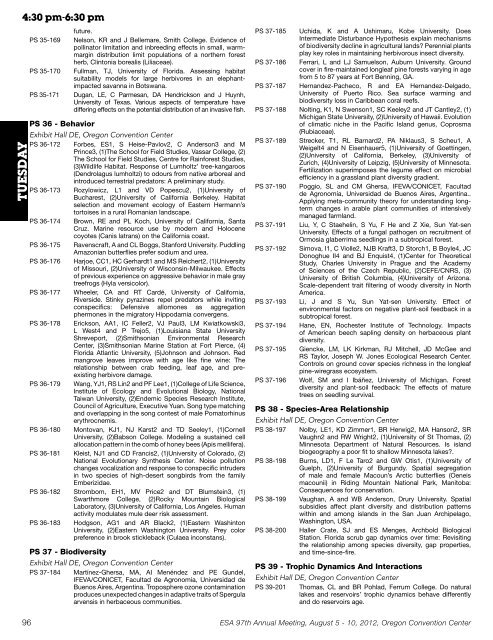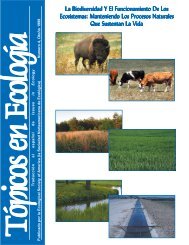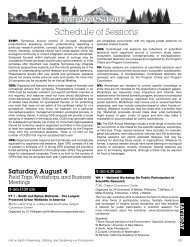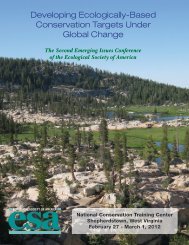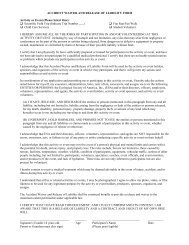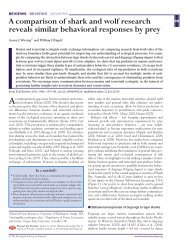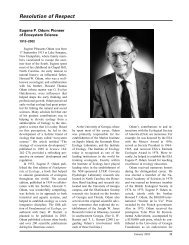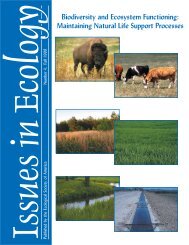Printed Program (PDF) - Ecological Society of America
Printed Program (PDF) - Ecological Society of America
Printed Program (PDF) - Ecological Society of America
You also want an ePaper? Increase the reach of your titles
YUMPU automatically turns print PDFs into web optimized ePapers that Google loves.
TUESDAY<br />
4:30 pm-6:30 pm<br />
future.<br />
PS 35-169 Nelson, KR and J Bellemare, Smith College. Evidence <strong>of</strong><br />
pollinator limitation and inbreeding effects in small, warmmargin<br />
distribution limit populations <strong>of</strong> a northern forest<br />
herb, Clintonia borealis (Liliaceae).<br />
PS 35-170 Fullman, TJ, University <strong>of</strong> Florida. Assessing habitat<br />
suitability models for large herbivores in an elephantimpacted<br />
savanna in Botswana.<br />
PS 35-171 Dugan, LE, C Parmesan, DA Hendrickson and J Huynh,<br />
University <strong>of</strong> Texas. Various aspects <strong>of</strong> temperature have<br />
differing effects on the potential distribution <strong>of</strong> an invasive fish.<br />
PS 36 - Behavior<br />
Exhibit Hall DE, Oregon Convention Center<br />
PS 36-172 Forbes, ES1, S Heise-Pavlov2, C Anderson3 and M<br />
Prince3, (1)The School for Field Studies, Vassar College, (2)<br />
The School for Field Studies, Centre for Rainforest Studies,<br />
(3)Wildlife Habitat. Response <strong>of</strong> Lumholtz’ tree-kangaroos<br />
(Dendrolagus lumholtzi) to odours from native arboreal and<br />
introduced terrestrial predators: A preliminary study.<br />
PS 36-173 Rozylowicz, L1 and VD Popescu2, (1)University <strong>of</strong><br />
Bucharest, (2)University <strong>of</strong> California Berkeley. Habitat<br />
selection and movement ecology <strong>of</strong> Eastern Hermann’s<br />
tortoises in a rural Romanian landscape.<br />
PS 36-174 Brown, RE and PL Koch, University <strong>of</strong> California, Santa<br />
Cruz. Marine resource use by modern and Holocene<br />
coyotes (Canis latrans) on the California coast.<br />
PS 36-175 Ravenscraft, A and CL Boggs, Stanford University. Puddling<br />
Amazonian butterflies prefer sodium and urea.<br />
PS 36-176 Harjoe, CC1, HC Gerhardt1 and MS Reichert2, (1)University<br />
<strong>of</strong> Missouri, (2)University <strong>of</strong> Wisconsin-Milwaukee. Effects<br />
<strong>of</strong> previous experience on aggressive behavior in male gray<br />
treefrogs (Hyla versicolor).<br />
PS 36-177 Wheeler, CA and RT Cardé, University <strong>of</strong> California,<br />
Riverside. Stinky pyrazines repel predators while inviting<br />
conspecifics: Defensive allomones as aggregation<br />
PS 36-178<br />
phermones in the migratory Hippodamia convergens.<br />
Erickson, AA1, IC Feller2, VJ Paul3, LM Kwiatkowski3,<br />
L West4 and P Trejo5, (1)Louisiana State University<br />
Shreveport, (2)Smithsonian Environmental Research<br />
PS 36-179<br />
Center, (3)Smithsonian Marine Station at Fort Pierce, (4)<br />
Florida Atlantic University, (5)Johnson and Johnson. Red<br />
mangrove leaves improve with age like fine wine: The<br />
relationship between crab feeding, leaf age, and preexisting<br />
herbivore damage.<br />
Wang, YJ1, RS Lin2 and PF Lee1, (1)College <strong>of</strong> Life Science,<br />
Institute <strong>of</strong> Ecology and Evolutional Biology, National<br />
Taiwan University, (2)Endemic Species Research Institute,<br />
Council <strong>of</strong> Agriculture, Executive Yuan. Song type matching<br />
and overlapping in the song contest <strong>of</strong> male Pomatorhinus<br />
erythrocnemis.<br />
PS 36-180 Montovan, KJ1, NJ Karst2 and TD Seeley1, (1)Cornell<br />
University, (2)Babson College. Modeling a sustained cell<br />
allocation pattern in the comb <strong>of</strong> honey bees (Apis mellifera).<br />
PS 36-181 Kleist, NJ1 and CD Francis2, (1)University <strong>of</strong> Colorado, (2)<br />
National Evolutionary Synthesis Center. Noise pollution<br />
changes vocalization and response to conspecific intruders<br />
in two species <strong>of</strong> high-desert songbirds from the family<br />
Emberizidae.<br />
PS 36-182 Strombom, EH1, MV Price2 and DT Blumstein3, (1)<br />
Swarthmore College, (2)Rocky Mountain Biological<br />
PS 36-183<br />
Laboratory, (3)University <strong>of</strong> California, Los Angeles. Human<br />
activity modulates mule deer risk assessment.<br />
Hodgson, AG1 and AR Black2, (1)Eastern Washinton<br />
University, (2)Eastern Washington University. Prey color<br />
preference in brook stickleback (Culaea inconstans).<br />
PS 37 - Biodiversity<br />
Exhibit Hall DE, Oregon Convention Center<br />
PS 37-184 Martínez-Ghersa, MA, AI Menéndez and PE Gundel,<br />
IFEVA/CONICET, Facultad de Agronomía, Universidad de<br />
Buenos Aires, Argentina. Troposphere ozone contamination<br />
produces unexpected changes in adaptive traits <strong>of</strong> Spergula<br />
arvensis in herbaceous communities.<br />
PS 37-185 Uchida, K and A Ushimaru, Kobe University. Does<br />
Intermediate Disturbance Hypothesis explain mechanisms<br />
<strong>of</strong> biodiversity decline in agricultural lands? Perennial plants<br />
play key roles in maintaining herbivorous insect diversity.<br />
PS 37-186 Ferrari, L and LJ Samuelson, Auburn University. Ground<br />
cover in fire-maintained longleaf pine forests varying in age<br />
from 5 to 87 years at Fort Benning, GA.<br />
PS 37-187 Hernandez-Pacheco, R and EA Hernandez-Delgado,<br />
University <strong>of</strong> Puerto Rico. Sea surface warming and<br />
biodiversity loss in Caribbean coral reefs.<br />
PS 37-188 Nolting, K1, N Swenson1, SC Keeley2 and JT Cantley2, (1)<br />
Michigan State University, (2)University <strong>of</strong> Hawaii. Evolution<br />
<strong>of</strong> climatic niche in the Pacific Island genus, Coprosma<br />
(Rubiaceae).<br />
PS 37-189 Strecker, T1, RL Barnard2, PA Niklaus3, S Scheu1, A<br />
Weigelt4 and N Eisenhauer5, (1)University <strong>of</strong> Goettingen,<br />
(2)University <strong>of</strong> California, Berkeley, (3)University <strong>of</strong><br />
Zurich, (4)University <strong>of</strong> Leipzig, (5)University <strong>of</strong> Minnesota.<br />
Fertilization superimposes the legume effect on microbial<br />
efficiency in a grassland plant diversity gradient.<br />
PS 37-190 Poggio, SL and CM Ghersa, IFEVA/CONICET, Facultad<br />
de Agronomía, Universidad de Buenos Aires, Argentina..<br />
Applying meta-community theory for understanding longterm<br />
changes in arable plant communities <strong>of</strong> intensively<br />
managed farmland.<br />
PS 37-191 Liu, Y, C Staehelin, S Yu, F He and Z Xie, Sun Yat-sen<br />
University. Effects <strong>of</strong> a fungal pathogen on recruitment <strong>of</strong><br />
Ormosia glaberrima seedlings in a subtropical forest.<br />
PS 37-192 Simova, I1, C Violle2, NJB Kraft3, D Storch1, B Boyle4, JC<br />
Donoghue II4 and BJ Enquist4, (1)Center for Theoretical<br />
Study, Charles University in Prague and the Academy<br />
<strong>of</strong> Sciences <strong>of</strong> the Czech Republic, (2)CEFE/CNRS, (3)<br />
University <strong>of</strong> British Columbia, (4)University <strong>of</strong> Arizona.<br />
Scale-dependent trait filtering <strong>of</strong> woody diversity in North<br />
<strong>America</strong>.<br />
PS 37-193 Li, J and S Yu, Sun Yat-sen University. Effect <strong>of</strong><br />
environmental factors on negative plant-soil feedback in a<br />
subtropical forest.<br />
PS 37-194 Hane, EN, Rochester Institute <strong>of</strong> Technology. Impacts<br />
<strong>of</strong> <strong>America</strong>n beech sapling density on herbaceous plant<br />
diversity.<br />
PS 37-195 Giencke, LM, LK Kirkman, RJ Mitchell, JD McGee and<br />
RS Taylor, Joseph W. Jones <strong>Ecological</strong> Research Center.<br />
Controls on ground cover species richness in the longleaf<br />
pine-wiregrass ecosystem.<br />
PS 37-196 Wolf, SM and I Ibáñez, University <strong>of</strong> Michigan. Forest<br />
diversity and plant-soil feedback: The effects <strong>of</strong> mature<br />
trees on seedling survival.<br />
PS 38 - Species-Area Relationship<br />
Exhibit Hall DE, Oregon Convention Center<br />
PS 38-197 Nolby, LE1, KD Zimmer1, BR Herwig2, MA Hanson2, SR<br />
Vaughn2 and RW Wright2, (1)University <strong>of</strong> St Thomas, (2)<br />
Minnesota Department <strong>of</strong> Natural Resources. Is island<br />
biogeography a poor fit to shallow Minnesota lakes?.<br />
PS 38-198 Burns, LD1, F Le Taro2 and GW Otis1, (1)University <strong>of</strong><br />
Guelph, (2)University <strong>of</strong> Burgundy. Spatial segregation<br />
<strong>of</strong> male and female Macoun’s Arctic butterflies (Oeneis<br />
macounii) in Riding Mountain National Park, Manitoba:<br />
Consequences for conservation.<br />
PS 38-199 Vaughan, A and WB Anderson, Drury University. Spatial<br />
subsidies affect plant diversity and distribution patterns<br />
within and among islands in the San Juan Archipelago,<br />
Washington, USA.<br />
PS 38-200 Haller Crate, SJ and ES Menges, Archbold Biological<br />
Station. Florida scrub gap dynamics over time: Revisiting<br />
the relationship among species diversity, gap properties,<br />
and time-since-fire.<br />
PS 39 - Trophic Dynamics And Interactions<br />
Exhibit Hall DE, Oregon Convention Center<br />
PS 39-201 Thomas, CL and BR Pohlad, Ferrum College. Do natural<br />
lakes and reservoirs’ trophic dynamics behave differently<br />
and do reservoirs age.<br />
96 ESA 97th Annual Meeting, August 5 - 10, 2012, Oregon Convention Center


